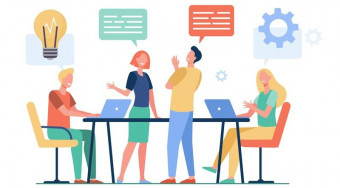Investigative Journalism
Tags: Journalism
How to find hidden sources. How to look for documents and people.
Last updated 2022-01-10 | 4.3
- You will be able to find interesting- innovative and original story ideas with impact.
- You will be able to turn a broad story idea into a realistic and demonstrable research hypothesis.
- You will be able to identify and cultivate necessary and available sources (paper trail and people trail).
What you'll learn
* Requirements
* You should be interested in news and have a (journalistic) curiosity.Description
Hello and welcome to this course on Investigative Journalism!
Before a journalist can write a copy, he or she has to gather the required information that the text will be about. This is called investigation or research.
However, investigation is not only a method, it’s also a philosophy. Why? Because a solid investigation is what distinguishes quality journalism from bad journalism. Today, many criticize that journalism has become “churnalism” – written with “ch” – which is a bad expression for the fact that many journalists don’t invest time in information gathering. There’s also the expression of “bandwagon journalism” which means that one journalist just copies and rewrites a text by a colleague – again: without an own research on the topic. All this is very bad. It’s bad because the very task of journalism is to properly inform the recipient – that is the reader or the radio or TV audience – about facts. It is obvious that the journalist has to know everything about these facts before he or she writes about them. And the journalist has to make sure these are really facts – that means they are true.
Now, when it comes to investigation as a method you might first think about using a search engine and just type in what you’re looking for. But as an investigative journalist you definitely have to dig deeper. Everybody can look something up in the internet. Your task as a professional journalist is to find the things that aren’t obvious.
Our course has four main sections. In the first section, we will talk about strategies to find good stories. This is a hard task. Without a good story, there is no investigation, and no writing.
Second, you’re going to learn how to phrase minimum and maximum hypotheses. These will guide your further investigation efforts. Your hypotheses can be true or false. The purpose of the investigation is to find out which one is the case.
Third, we will cover the research process. How can you find sources? What kinds of sources are there? How can you build a timeline? How do you look for documents or for people?
Finally, we will talk about how to tell a story, that is: how to outline the masterfile and which narrative principles to follow. You will get some writing tips and you will learn how fact-checking and bulletproofing is done.
You see: Investigation is an essential part of a professional journalist’s toolkit – maybe even the most important one. In this course, we will teach you everything you need to know for your solid investigation.
See you in the course!
This course is based on a script written by Margo Smit. Margo is an independent investigative journalist, journalism teacher, and (part-time) director of the Dutch-Flemish Association of Investigative Journalists (VVOJ). She is a lecturer for TV reporting and investigative reporting at University of Groningen, The Netherlands. She produces documentaries in Dutch and English, both for Dutch public television and for international companies. Smit teaches investigative and TV journalism at the Rijksuniversiteit Groningen, and is a guest lecturer at many international journalism schools. Smit sat on the Global Shining Light Award jury (2010), the jury of the Daniel Pearl Award (2010, 2011, 2013), and the M.J. Brusseprijs (2013). She received her Master's degree in Communication (specialization journalism) from Stanford University, Palo Alto, USA.
Who this course is for:
- Students who want to become professional journalists.
Course content
1 sections • 8 lectures
Finding the Story Preview 13:52
Learning outcomes
After working through this chapter, you will be able to:
- systematically look for story ideas;
- generate story ideas worth inquiring into;
- evaluate what constitutes a feasible story;
- do a quick feasibility scan on the research topic;
- build a ‘sales pitch’ for a story idea (and thus turn a (perhaps initially rather vague) story idea into a solid starting point for a successful journalistic inquiry).
Quiz: Finding the story
Towards a systematic approach Preview 13:26
Quiz: Towards a systematic approach
Researching the story Preview 21:19
“The key is to take sources as seriously as they take themselves and show a genuine interest in them, what they’ve written, what they’ve said, and jobs they’ve had before. There are three other keys: listening, listening, listening.”
— Bob Woodward, at a visit to the Poynter Institute on March 15, 2011.
Learning outcomes
At the end of this lecture, you will know:
- what different kinds of sources to use in a research project;
- how to make an inventory of possible sources (people, documents, data);
- how to systematically look for the ‘paper trail’ and the ‘people trail’ and to verify sources;
- how to build a sources map and a project file;
- how to use sources as building blocks for a story;
- how to research ‘for facts’ and research ‘for story’;
- and how to work your way into an inquiry from the outside in
Quiz: Researching the story
Telling the story Preview 19:57
“Writing is thinking. It is an extension of the reporting process.”
— Walt Harrington, long-time writer and journalism professor at the University of Illinois at Urbana-Champaign (Kramer & Call 2007: 97)
Learning outcomes
After working through this lecture, you will be able to:
- turn your timeline into a story outline;
- turn your research and outline into a publishable, written or filmed, story;
- address ethical and deontological aspects of the inquiry;
- ‘bulletproof’ your inquiry;
- and achieve what we set out to do at the start of this module: publish a story that makes a change.








 This course includes:
This course includes:
















